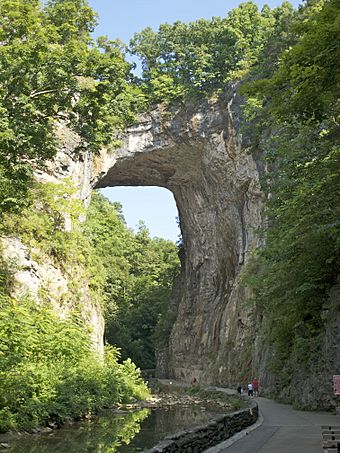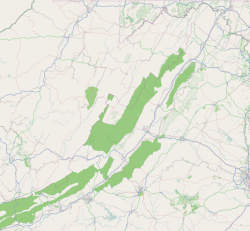Natural Bridge (Virginia) facts for kids
Natural Bridge is an amazing rock formation in Rockbridge County, Virginia. It's like a giant stone arch, about 215 feet (66 meters) tall. The arch itself spans about 90 feet (27 meters) wide.
This natural wonder sits in a deep valley, or gorge. Cedar Creek, a small stream that flows into the James River, carved out this gorge. The bridge is made of flat layers of limestone. It's actually the remains of the roof of an ancient cave or tunnel. Long ago, Cedar Creek flowed right through this underground passage!
Natural Bridge is so special that it's been named a Virginia Historic Landmark and a National Historic Landmark. Since 2016, the bridge and the land around it have been protected. It is now managed by the state of Virginia as Natural Bridge State Park.
How Natural Bridge Formed
The rocks at Natural Bridge are mostly limestone and dolomite. These types of rocks formed about 470 million years ago. They were created from tiny bits of ancient sea creatures and minerals that settled on the bottom of a sea.
The layers of rock that make up Natural Bridge are mostly flat. This is interesting because nearby rocks are often tilted or folded. This flat layering helps scientists understand how the bridge was created.
Scientists aren't completely sure about every step of the bridge's formation. But they agree on a few important things. These include the way the rock layers tilt, how water slowly dissolves rock, and the many cracks in the stone.
One popular idea, suggested by scientist Edgard W. Spencer, explains it well. He believes Natural Bridge is what's left of an underground river tunnel. This tunnel once carried water to the south. Over millions of years, water slowly dissolved the rock, and parts of the tunnel collapsed. The Natural Bridge is the only part of the tunnel's roof that survived.
As the underground river grew, it helped form the deep gorge we see today. The creek's flow increased, making the distance from the water to the tunnel roof much greater. Today, you can see a "Lost River" about half a mile upstream from the bridge. This "Lost River" disappears into the ground, which helps support the idea of an ancient underground river.
A Look at History

Natural Bridge was a very important and sacred place for the Monacan tribe. They were a Native American group who lived in this area. They believed it was the site of a big victory over another tribe, the Powhatans, long before Europeans arrived.
In 1742, a frontiersman named John Howard explored this area. He and his group followed Cedar Creek right through Natural Bridge. They then traveled by boat down several rivers all the way to the Mississippi River.
It's said that George Washington visited the site in 1750 when he was a young surveyor. To prove this, tour guides point to the initials "G.W." carved into the bridge wall, about 23 feet (7 meters) up. Legend also says that Washington threw a rock from the bottom of Cedar Creek over the bridge! In 1927, a large stone was found with "G.W." and a surveyor's cross carved into it. Many historians believe this proves he did survey the bridge.
Thomas Jefferson bought 157 acres (64 hectares) of land, including Natural Bridge, in 1774. He bought it from King George III for a small sum. Jefferson called it "the most Sublime of nature's works." He built a small log cabin there, with a room for guests. It became a favorite retreat for him. Even when he was President in 1802, he personally surveyed the area again. Many famous people stayed there, like John Marshall and James Monroe.
Natural Bridge became a popular tourist spot for Europeans in the 1700s and 1800s. Visitors from all over the world would take day trips from the bridge to explore the countryside. In 1833, a new owner built the Forest Inn to house the growing number of visitors.
The bridge was very famous in the 1800s. The writer Herman Melville even mentioned it in his famous book Moby-Dick. He compared a whale's arching body to Virginia's Natural Bridge. Another American writer, William Cullen Bryant, said Natural Bridge and Niagara Falls were the two most amazing natural features in North America.
In 1927, special lights were added to shine on the arch and gorge at night. President Calvin Coolidge officially turned on the lights. Today, the original light show has been replaced. Now, there's a sound and light show that tells the story of the biblical seven days of Creation.
In 2013, almost 1,500 acres (607 hectares) of land, including the bridge, were going to be sold. To stop the land from being divided up, the Virginia Conservation Legacy Fund (VCLF) bought the bridge, hotel, and surrounding land for $9.1 million. They got a loan from the Virginia Clean Water Revolving Loan Fund to do this. When VCLF had trouble making payments, the state of Virginia offered to manage the property as a Virginia State Park.
Natural Bridge State Park
Natural Bridge State Park officially opened on September 24, 2016. The Virginia Department of Conservation and Recreation manages the park. However, the VCLF still owns the land. It's the only state park that operates on privately owned land. The property will become state-owned once the original loan is fully paid back. The VCLF still owns and manages the nearby Natural Bridge Hotel and Natural Bridge Caverns.
Visitors need to buy tickets to see the bridge from below. The park's fees under state management are about half of what they used to be. U.S. Route 11 (Lee Highway) actually runs right over the top of the bridge. But fences make it hard to see anything from the road.
The state park includes several popular attractions. There's a trail that goes under the bridge and along Cedar Creek. You can also see a recreation of Monacan Native American housing. And don't miss the 30-foot (9-meter) tall Lace Falls! The "Drama of Creation" light show still happens in the evening, even after the park officially closes.
One change since it became a state park was the removal of Foamhenge. This was a full-size copy of Stonehenge made entirely out of styrofoam. It was moved to Fairfax County because it didn't fit with the state park's goals.
In 2016, the new state park was named an "Affiliated Area" by the National Park Service. This means the federal government doesn't own or manage it. But it does allow them to offer technical and financial help.
Images for kids
-
Natural Bridge by Frederic Edwin Church, 1852









